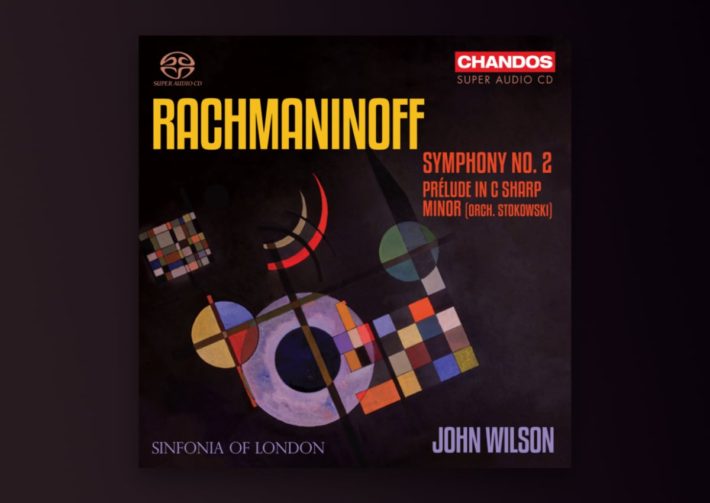John Wilson and the Sinfonia of London return for a second installment in their Rachmaninoff series; the first featured Symphony No. 3 and the Op. 29 Isle of the Dead. Symphony No. 2 (1906-07) is one of the composer’s longest works at nearly an hour, which, in earlier recordings (Kurt Sanderling or 1930s Ormandy) resulted in cuts and omissions of repeats.
The heavy darkness we hear in the Largo (track 2) could well be Rachmaninoff’s reflection upon his period of immense personal struggle just years prior. The Sinfonia’s low strings do a nice job in deriving an ominous whisper while the violins’ slides create wistful sighs. Moments like the deceptive cadence at 1’00” would benefit from more color changes from the winds, however. It is this want for contrast that becomes a more perennial issue in later movements.
Wilson and Sinfonia meet the technical demands of the Allegro Molto (track 3), the violins again delivering with their pristine articulation. The true vivacious spirit, however, lies in dynamic personality shifts between sections: this is where things are lacking. Glossy, well-balanced sonorities start sounding the same halfway in. And while a uniformly polished tone quality shouldn’t be something to complain about, it can be a considerable drawback in this particular movement. Perhaps due to overly-done sound engineering, the important horn calls in the beginning feel disappointingly relegated to the very back of the stage. The Ticciati/DSO 2021 recording from 2021 (reviewed here) might have a similar issue where over-control is concerned, but the prevalence of the brass is far more satisfying and delivers greater dimensionality. Simon Rattle/LSO (LSO Live) probably does this movement best: there is a galloping urgency that keeps us on the edge of our seats. Rattle does know just how and when to rein things in, though: the softer sections shift gears with plenty of control and touches of buoyancy.
Related Classical Music Reviews
- Review: Hollywood Soundstage – Wilson, Sinfonia of London
- Double Review: Ravel – Orchestral Works – Wilson, Oramo
- Review: Respighi – Roman Trilogy – Sinfonia of London, John Wilson
The Adagio might arguably be one of the most beautiful things Rachmaninoff has ever written. The melodies, harmonies, and interaction between the secondary and melodic lines all speak to sentiments that are simultaneously evocative and sensitive. The Sinfonia’s attention to detail in the undulating accompaniment gives us a chance to savor the composer’s array of ever-shifting harmonic colors. Just like the slow movement of the Second Piano Concerto, a central part of this Adagio is the clarinet solo; this one feels regrettably bland, largely due to a lack of phrase shaping. Moments like 1’30” don’t exactly help, either: the soloist attempts a delicate pianissimo but the sound simply disintegrates. Previn & the LSO’s second account (1973) gives the wind’s line a much more vocal quality and long arc, not to mention a sweeping nostalgia in the orchestral opening.
The Allegro vivace finale (track 5) marks a jubilant and triumphant end to the epic journey. But much like the second movement, the interpretation feels watered down—granted, there are plenty of moments of overt gaiety but that extra something remains missing. An example begins shortly before the section at 2’46”: the closure of the previous section is rushed, rather than giddy. The brass do their due diligence with definitive blasts to mark the arrival of the new material but the strings don’t quite ride the momentum. Rachmaninoff writes quite the romantic theme at 3’04” and it’s too bad that not enough of its panoramic contour and rhapsodic passion are captured. Turn to Mariss Jansons/Philharmonia (Chandos), where the nearly unbridled joviality comes from the swifter tempo, unabashed horns, and dramatic swells. Those wanting to take the tempo even further up a notch can look to the Bychkov/Orchestre de Paris performance (1991). Breakneck speed as it is, articulation remains delightfully clear and light.
The challenge of this symphony is to create and support unfailing variety and narrative drama—and make a compelling hour’s worth of music. While there are indeed aspects of polished musicianship in the WIlson recording (particularly in detailed moments), what’s ultimately missing is the greater sense of structure, contour, and drive. Maybe this is why this performance doesn’t stand out in the face of established recordings that remain the strongly preferred points of reference.
Rachmaninoff Symphony No. 2, & Prelude in C# Minor
Sinfonia of London
John Wilson – Conductor
Chandos, CD CHSA5309



















